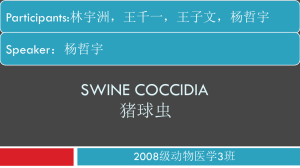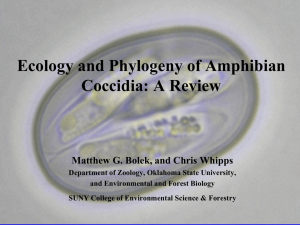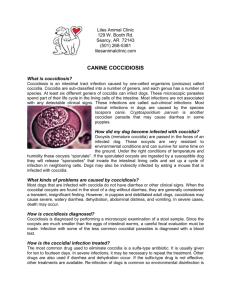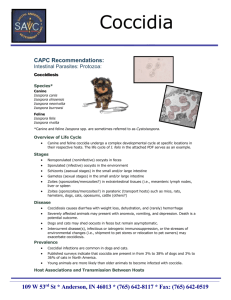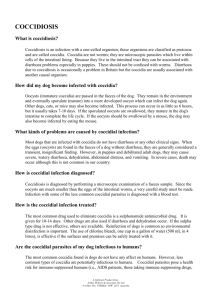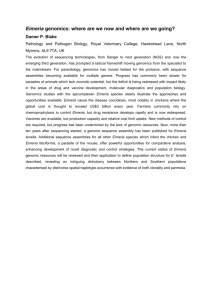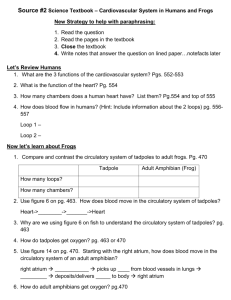Amphibian Coccidia: Taxonomy, Host Specificity, Ecology, and Phylogeny. Steve J. Upton
advertisement
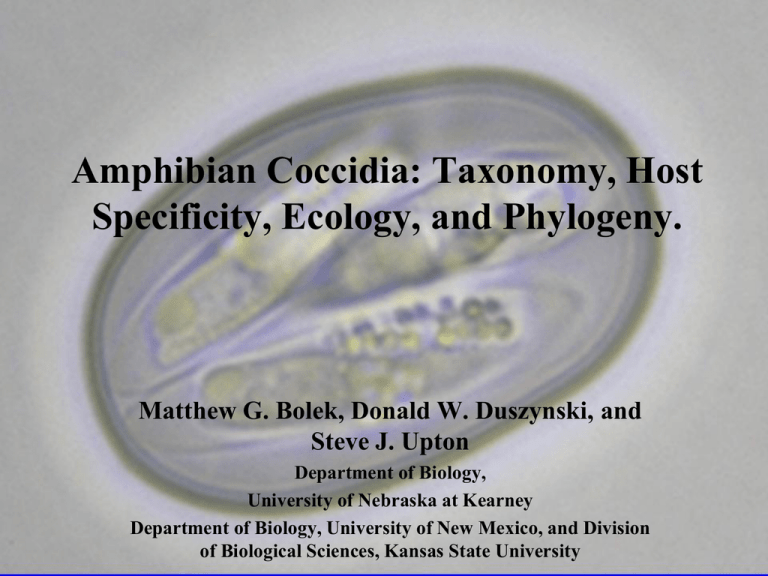
Amphibian Coccidia: Taxonomy, Host Specificity, Ecology, and Phylogeny. Matthew G. Bolek, Donald W. Duszynski, and Steve J. Upton Department of Biology, University of Nebraska at Kearney Department of Biology, University of New Mexico, and Division of Biological Sciences, Kansas State University 6,009 Extent Species of Amphibia (Frost, 2007) Anura Caudata Gymnophiona Amphibian Coccidia • Coccidia of frogs and toads, salamanders and newts, and caecilians are the least known of all the tetrapod vertebrate classes. Generalized Life Cycle of a Coccidian 2 3 1 Generalized Life Cycle of a Coccidian 1 Generalized Life Cycle of a Coccidian 2 Generalized Life Cycle of a Coccidian 3 The Frogs and Toads (Anurans) Anurans • 5,453 extant species of frogs and toads in 395 genera and 45 families. Anurans • Of the 5,453 anuran species, only 1.2% (67/5,453) of species in 7.6% (30/395) of the genera and 31.1% (14/45) of the families have ever been examined for coccidia. Anurans • 18 species of Eimeria, 2 species of Goussia, 1 species of Hyaloklossia and 9 species of Isospora have been described. 4X2 4X2 2X4 2X4 Anuran Coccidia World Distribution 8 7 7 4 3 * Eimeria spp. of Anurans Ovoidal Irregular Spherical Variation in Oocyst Morphology Stieda body Oocyst Residium Micropile Cap Micropile Variation in Endogenous Development Extranuclear Intranuclear Bolek unpublished; Jirků and Modrý 2005 Variation in Sporulation Exogenous Endogenous Bolek unpublished; Duszynski et al., 2007 Morphotypes of Anuran Eimeria OR MT 1 6 + MT 2 4 - MT 3 1 - MT 4 2 - SB ++ + + - MC - - + - Development En In In En Sporulation Ex Ex Ex En No. spp. Caudatans • 560 extant species of salamanders and newts in 64 genera and 9 families. Caudatans • Of the 560 caudatan species, only 8.0% (45/560) of species in 28.1% (18/64) of the genera and 67% (6/9) of the families have ever been examined for coccidia. Caudatans • 19 Eimeria and 2 Isospora species have been described from the 560 described caudatan species. Caudatan Coccidia World Distribution 12 6 3 19 Eimeria spp. of Caudata Elliptical Spherical-Subspherical Morphotypes of Caudata Eimeria OR MT 1 4 + MT 2 6 - MT 3 2 +/- MT 4 2 - SB + + + - MC - - + - Development En En In ? Sporulation Ex Ex Ex Ex No. spp. Gymnophionans • 121 extant species of caecilians in 14 genera and 3 families. Gymnophionans • Only 1 Eimeria species has been described from caecilians. Eimeria dermophis Asmundsson, Campbell and Duszynski, 2000 Host Specificity and Ecology of Amphibian Coccidia Host Specificity and Ecology • Few studies exist on host specificity of coccidian parasites of amphibians. • Lavier (1941) was unable to infect the common European toad with I. brumpti recovered from the green toad. • Anuran coccidia are genus specific; whereas some caudatan coccidia can infect numerous genera of salamanders in the same family. • How do amphibians become infected with these coccidia species? • Examination of field collected tadpoles of western chorus frogs indicated that they shed oocysts of Eimeria streckeri, Isospora cogginsi and Isospora delicatus. Prevalence of Eimeria streckeri in Adults, Tadpoles, and Metamorphosed Western Chorus Frogs N = 102 N = 44 N = 47 N = 45 Prevalence of Isospora cogginsi in Adults, Tadpoles, and Metamorphosed Western Chorus Frogs N = 102 N = 44 N = 47 N = 45 Prevalence of Isospora delicatus in Adults, Tadpoles, and Metamorphosed Western Chorus Frogs N = 102 N = 44 N = 47 N = 45 We collected western chorus frog eggs, brought them into the laboratory, and reared tadpoles. Experimental Infections We exposed these tadpoles to coccidia oocysts. 90% (18/20) of experimentally exposed tadpoles of western chorus frogs shed oocysts of Isospora delicatus. Tadpoles shed oocysts 9-10 days post exposure, and continued shedding oocysts for 7 days, and did not retain the infection before metamorphosis. Sporulation: Exogenous. Tadpole and metamorphosed frog digestive system. Other Anuran Coccidia • Goussia spp. only infect tadpoles and are lost during metamorphosis, but sporulated oocysts are found in the liver sinuses of metamorphosed anurans. • Hyaloklossia sp. infects tadpole and metamorphosed anuran kidneys and survives metamorphosis. Salamander larvae feed on live prey in the open water column and therefore few should be infected with coccidia N = 20 N = 19 N = 20 N = 14 100% (9/9) of metamorphosed tiger salamanders shed oocysts of Eimeria ambystomae. Conclusion • 5,896 of the 6,009 (98%) of the amphibian species have not been examined for coccidia parasites. • Field data suggests that coccidia of anurans are genus specific; whereas coccidia of caudatans are genus or family specific. • Goussia spp. exhibit stadial host specificity in tadpoles, whereas Eimeria, Hyaloklossia and Isospora species can infect larval and adult amphibians. • No phylogeny exist for amphibian coccidia. Acknowledgments • Miloslav Jirků (University of Vet & Pharm Scie, Czech Republic) • Dr. Armando Irizarry-Rovira (Eli Lilly and Co.) • Cedar Point Biological Station • UNL School of Biological Sciences Special Funds, Initiative for Ecological and Evolutionary Analysis UNL, Center for Great Plains Studies
